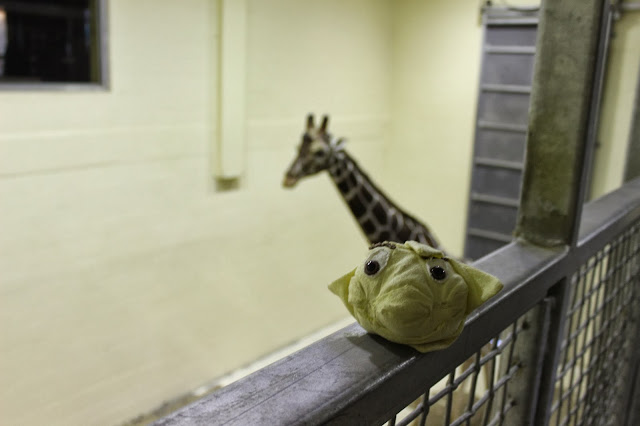Little Star also got to make a couple early debuts and meet some colleagues outside the Planetarium world. The conference paired at times with the Illinois Association of Museums (IAM) as well, so he met many professionals from museums, zoos and NASA as well.
 |
| Is that giraffe going to eat me?! Seriously, he's walking over here! |
 |
| Little Star meets Astronaut Scott Altman, commander of the last servicing mission of the Hubble Space Telescope |
Many of my colleagues told me as well over the first couple days before I presented my paper that they have shown or currently show Little Star in their own Planetariums and that they were curious about my paper.
I was very grateful for their encouragement in the days leading up to my presentation because I was pretty nervous. I've always loved public speaking/theater/teaching, and speech giving has always come naturally to me. This was the first time, however, that I presented an academic paper or spoken in front of my colleagues in my chosen field. So maybe nervous is an understatement - terrified probably sums it up better.
Fortunately, my father had a lot of practice presenting academic papers over the years and helped me prepare for the best and the worst, so at least I had that in my back pocket. I also had a lot of friendly faces in my audience (which normally scares me more to have people I know listening, but this time it was also nice).
When the time came, I presented my paper (which I know was recorded and if I find a copy I will try to post here). I covered all the details I could in my ten minutes; making sure to discuss why reaching out to visitors who are blind/have low vision is important, how it fits in with elementary school science standards, how the program works and the results of the first couple of runs of the program.
 |
| Talking about the 1:40 Scale Model of the Zeiss Universarium Mark IX and Orthwein StarBay of the McDonnell Planetarium |
 |
| Presenting all the tactile and microwavable star characters |
 |
| Talking about the tactile follow-along book in twin vision |
When I was done there was some time for questions and I braced myself not knowing what to expect. I had three questions posed to me:
Q) "Is this program available to other Planetariums?"
A) My goal was to have the program available to other planetaria world wide once I got it going at my own. The time for it to start making its way into the world is quite soon now, I think!
Q) "Who makes the tactiles and would it be possible to get a set of the star characters and/or a book?"
A) I currently am the only one making all the components of the program. I would be happy to make some for you but in all honesty it might take me a while.
Q) "Could you explain Lighthouse for the Blind - Saint Louis' role a little more?"
A) LHB was absolutely wonderful in providing insight into the program and giving advice on what would and would not work. The support they provided, both financially and otherwise had been incredible. They are the reason that the program was able to take off and start reaching its target audience. Without LHB, this program would still be a dream that I turned in as a paper my first semester in grad school.
And then my time was up. It went far better than I expected! I received nothing but kind words and excitement that matched my own about my program. Several of my colleagues have now expressed interest in having the program at their own Planetariums and I hope that very soon we can make that happen! It was absolutely amazing to have the program recognized so highly by my colleagues!
The other really cool thing was that I got to meet representatives from Audio-Visual Imagineering (AVI) - the company that re-produced The Little Star That Could in 2005 to update the changes to Pluto and make the show full-dome. They were incredibly kind and it was a lot of fun to show them what I'd made. Later in the day after my presentation, they also offered to help me with Feeling the Stars! Hopefully this really does mean that soon there will be more Planetaria with my program, reaching out to their own visitors in need of the adaptive elements! I was so excited and moved by everyone's generosity, excitement and kindness!
I know I end a lot of my posts with thank yous, but I could not have gotten the program to where it is without the people I thank...
I have to thank Seiler Instruments for your generosity in helping me get to GLPA, for believing in me and my program and most importantly, for believing in my Planetarium. I also want to thank my mentor, John, as well as Brian for your continual encouragement and support of me and my program and Bill and Eric for your support and for covering for me in my absence. Thank you to Ann and Wilfried from Carl Zeiss too for taking time out of your busy schedule to listen to my paper! Thank you to my parents for your continued support - especially my dad for helping me prepare for my presentation. And finally, to all my colleagues from GLPA who have given me so much encouragement to continue with my work - I thank you from the bottom of my heart!
No comments:
Post a Comment